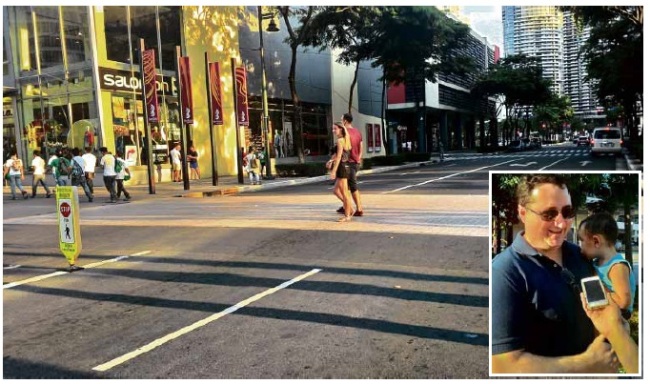Foreigners find it more fun in the Philippines, until they cross the streets
By Korea HeraldPublished : May 26, 2015 - 20:27
They say the mark of a truly mature motorist is how he or she treats the non-motorized individuals who share the road with him or her. And mature motorists aren’t necessarily a result of any economic fortune (or misfortune) befalling a nation.
As many harrowing videos on YouTube and other social media sites are showing with increasing frequency, developed, developing and “stagnated” countries have their fair share of “monster” drivers who show utter disregard for road rules and etiquette.
The Philippines is no exception. Even as the country experiences a seemingly sustainable surge in economic growth including a noticeable foreign visitor arrivals bump (456,163 this March compared with 425,858 the same month in 2014, according to the tourism department), down at the streets, things tend to go primeval, and it’s every man ― foreigner or local ― for himself.
As many harrowing videos on YouTube and other social media sites are showing with increasing frequency, developed, developing and “stagnated” countries have their fair share of “monster” drivers who show utter disregard for road rules and etiquette.
The Philippines is no exception. Even as the country experiences a seemingly sustainable surge in economic growth including a noticeable foreign visitor arrivals bump (456,163 this March compared with 425,858 the same month in 2014, according to the tourism department), down at the streets, things tend to go primeval, and it’s every man ― foreigner or local ― for himself.

This reality came to mainstream media concern on May 12 when a female Thai national who was crossing on a pedestrian lane in Bonifacio Global City was sideswiped when two speeding SUVs (which apparently ignored the slow-down-at-intersections rule) collided with one another at an intersection with no stoplights installed.
The Thai national was rushed to the nearby hospital in critical condition. (As of press time, there has been no statement issued on the patient’s status.)
How “un-fun” is it, really, to cross Metro Manila’s streets? Inquirer Motoring did the rounds of the streets of BGC and the Makati central business district, and here are what foreigners have to say about the state of being a pedestrian in this country.
Nick Burnett, 48, is an American who has been doing his routine walks in BGC for just two weeks.
“It’s my first time in the Philippines. I’m not afraid to cross the streets here. It’s crowded, but you just have to watch the light and watch what you’re doing. And I don’t rush. So far, it hasn’t been scary at all. There has been some honking, but so far motorists have been courteous,” he said.
American Peter Malvicini, 50, has been a resident in Metro Manila for 15 years.
“Where there is a guard to help, things work well. Where there’s not, the cars do not obey. I don’t understand why, when there’s so much investment (here at BGC), there isn’t a guard at every crossing,” Malvicini said.
“You really have to pay attention (to the surroundings), because you can’t rely on the drivers. There should be a 4,000 pesos ($90) fine (on drivers who violate pedestrian rules), then they won’t do it again. If they can do it in Singapore and Hong Kong, why not enforce it here?”
Spaniard Fernando Ramos, 36, has been a Quezon City resident for eight years.
“(Road crossing safety) depends on the area. I think, in BGC it’s very safe. Also in Makati, it’s generally safe. In Manila, however, it’s more dangerous. They don’t respect the traffic signs there,” Ramos said.
“It’s in the nature of the city, so I just have to adjust. When I’m with my child, we only walk in places where there are not many cars. I have also been driving here for six years, and so far, I have been in only one minor accident with a jeepney. If you have to do defensive driving, you also have to do defensive walking,” he added.
Lithuanians Thomas Kebla, 25, and Carolina Klim, 25, have been working here for eight months. Both have experienced being pedestrians in Singapore, Hong Kong, Malaysia and the Maldives.
Said Kebla: “It’s still very safe in BGC, but in most places, I have to be cautious even on a green pedestrian light. The more dangerous are taxi drivers who are making right turns on the red light.”
Klim said: “The drivers are aware of pedestrian rights, so I don’t think there’s an issue compared to, say, India. It’s way safer here. And even compared to Vietnam where we learned to cross in way quicker traffic, I think it’s not too bad here. I feel rather safe here, to be honest.”
Klim added: “Here, drivers usually show turning signs, while drivers in some countries don’t bother to turn on their turn signals.”
By Tessa R. Salazar
(Philippine Daily Inquirer)
-
Articles by Korea Herald







![[Graphic News] More Koreans say they plan long-distance trips this year](http://res.heraldm.com/phpwas/restmb_idxmake.php?idx=644&simg=/content/image/2024/04/17/20240417050828_0.gif&u=)
![[KH Explains] Hyundai's full hybrid edge to pay off amid slow transition to pure EVs](http://res.heraldm.com/phpwas/restmb_idxmake.php?idx=644&simg=/content/image/2024/04/18/20240418050645_0.jpg&u=20240419100350)






![[From the Scene] Monks, Buddhists hail return of remains of Buddhas](http://res.heraldm.com/phpwas/restmb_idxmake.php?idx=652&simg=/content/image/2024/04/19/20240419050617_0.jpg&u=20240419175937)

![[KH Explains] Hyundai's full hybrid edge to pay off amid slow transition to pure EVs](http://res.heraldm.com/phpwas/restmb_idxmake.php?idx=652&simg=/content/image/2024/04/18/20240418050645_0.jpg&u=20240419100350)

![[Today’s K-pop] Illit drops debut single remix](http://res.heraldm.com/phpwas/restmb_idxmake.php?idx=642&simg=/content/image/2024/04/19/20240419050612_0.jpg&u=)